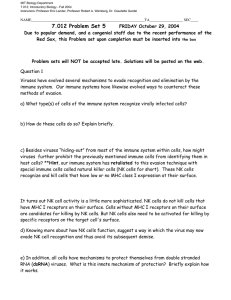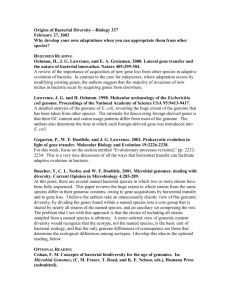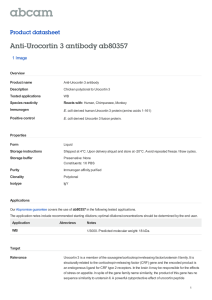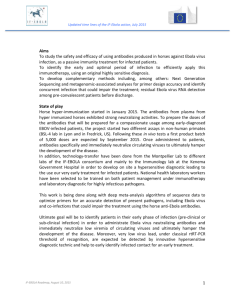Document 13478095
advertisement
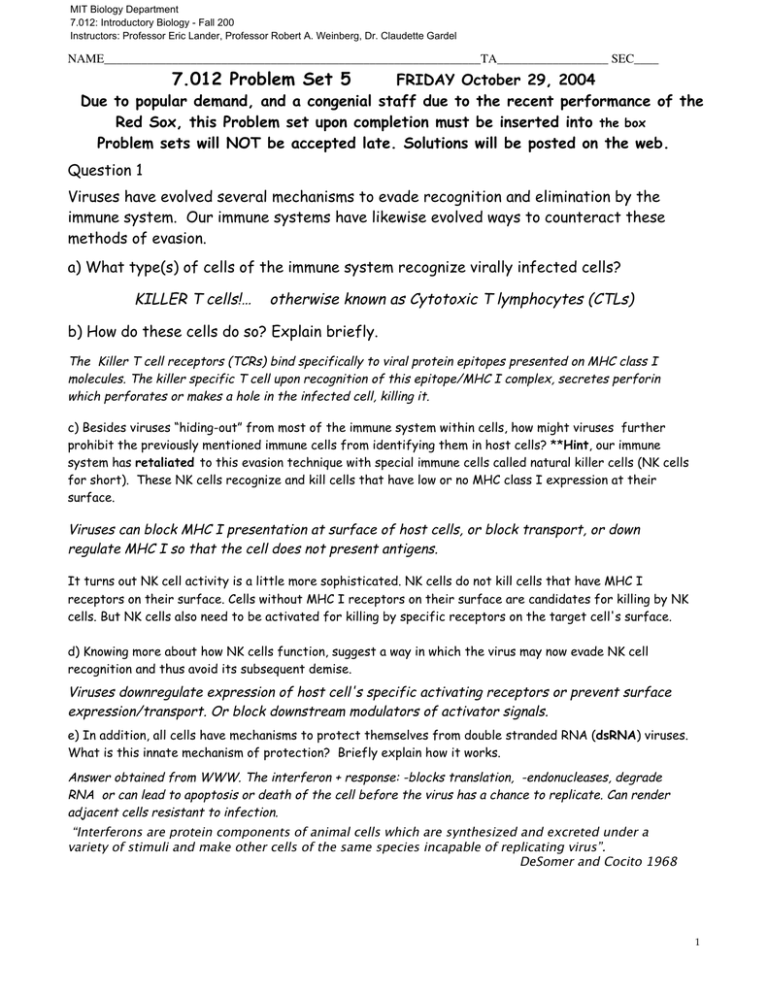
MIT Biology Department 7.012: Introductory Biology - Fall 200 Instructors: Professor Eric Lander, Professor Robert A. Weinberg, Dr. Claudette Gardel NAME_____________________________________________________________TA__________________ SEC____ 7.012 Problem Set 5 FRIDAY October 29, 2004 Due to popular demand, and a congenial staff due to the recent performance of the Red Sox, this Problem set upon completion must be inserted into the box Problem sets will NOT be accepted late. Solutions will be posted on the web. Question 1 Viruses have evolved several mechanisms to evade recognition and elimination by the immune system. Our immune systems have likewise evolved ways to counteract these methods of evasion. a) What type(s) of cells of the immune system recognize virally infected cells? KILLER T cells!… otherwise known as Cytotoxic T lymphocytes (CTLs) b) How do these cells do so? Explain briefly. The Killer T cell receptors (TCRs) bind specifically to viral protein epitopes presented on MHC class I molecules. The killer specific T cell upon recognition of this epitope/MHC I complex, secretes perforin which perforates or makes a hole in the infected cell, killing it. c) Besides viruses “hiding-out” from most of the immune system within cells, how might viruses further prohibit the previously mentioned immune cells from identifying them in host cells? **Hint, our immune system has retaliated to this evasion technique with special immune cells called natural killer cells (NK cells for short). These NK cells recognize and kill cells that have low or no MHC class I expression at their surface. Viruses can block MHC I presentation at surface of host cells, or block transport, or down regulate MHC I so that the cell does not present antigens. It turns out NK cell activity is a little more sophisticated. NK cells do not kill cells that have MHC I receptors on their surface. Cells without MHC I receptors on their surface are candidates for killing by NK cells. But NK cells also need to be activated for killing by specific receptors on the target cell's surface. d) Knowing more about how NK cells function, suggest a way in which the virus may now evade NK cell recognition and thus avoid its subsequent demise. Viruses downregulate expression of host cell's specific activating receptors or prevent surface expression/transport. Or block downstream modulators of activator signals. e) In addition, all cells have mechanisms to protect themselves from double stranded RNA (dsRNA) viruses. What is this innate mechanism of protection? Briefly explain how it works. Answer obtained from WWW. The interferon + response: -blocks translation, -endonucleases, degrade RNA or can lead to apoptosis or death of the cell before the virus has a chance to replicate. Can render adjacent cells resistant to infection. “Interferons are protein components of animal cells which are synthesized and excreted under a variety of stimuli and make other cells of the same species incapable of replicating virus”. DeSomer and Cocito 1968 1 Question 2 As a UROP in the Weinberg lab, one of your duties is to take care of the mice used for experimentation. During your tenure in the mouse facilities you notice a colony of mice that is highly susceptible to bacterial infections. In order to figure out why, you first take a blood sample and look at the levels of serum proteins. You are shocked to find that these mice lack antibodies in their serum! You are now aware of why they are so susceptible to infection. a) What cell type do you suspect is affected by this mutation? Plasma cells. With what little spare time you have from your lab duties and school work, you decide to try to figure out why there are no antibodies circulating in these mice. You find that the mutation that leads to the disease is within the immunoglobulin heavy chain locus. Sequencing the locus reveals that the mutation is a deletion of the C-terminal transmembrane domain of the heavy chain. You’re not an immunologist and frankly you were kind of surprised to learn that the antibody heavy chain has a transmembrane domain, afterall you always have been taught simply that antibodies are secreted. However, based on your knowledge of cell signaling that you learned in 7.012, you begin to think of the antibody as a receptor and thus can make sense of why it has a transmembrane domain. b) How does the transmembrane domain of the antibody enable the cell to signal from an “antibody receptor” to the nucleus? (Answer by comparing the alternative possibility in which the antibody is just secreted.) 'Antibody receptor' bridges antibody binding to cell stimulatory, mitogenic signaling. If antibodies were only secreted there wuld be no way for a cell to 'know' that the antibody (Ab) recognized and bound Antigen (Ag) and signal this information directly. c) Why might this signalling be important for antibody selection prior to secretion from the cell? Membrane bound antibodies that bind antigen very well could stimulate their cells to grow/expand (clonally expand –with of course further stimulation of a helper T cell). Antibodies expressed on cells that don't bind antigen well would lack mitogenic signals. d) Now hypothesize why these mutant mice lack antibodies in their circulation? Without being able to receive positive mitogenic signals, these cells do not get the signal to clonally expand, and thus differientate into plasma cells which secrete antibodies. 2 Serum antibodies to bacterial wall components Question 3 greater response than primary response more rapid response than after 1st infection Primary response time 1st Bacterial Infection 2nd Bacterial Infection Note that the 2nd bacterial infection in the figure above would have had to be an infection with exactly the same kind of bacterium as the first infection. For instance, a Bordatella pertussis (whooping cough) infection followed by a second Bordatella infection at a later time point. A Bordetella infection followed by a different bacterial infection, for instance, Bacillus anthracis (anthrax) would show a different graph. Serum antibodies to bacterial wall components The diagram above depicts a typical antibody response to a primary and secondary bacterial infection in wildtype mice. Being that it is the week following Halloween and you have an abundance of candy, you decide to feed your mice some of the “more suspect” candy that you got from some creepy old ladies whom you think may have tricked rather than treated. Indeed, after putting the mice on the candy diet you find that their antibody response has changed! It now looks like this… same delay in antibody response as in 1st infection no increase in magnitude of response time 1st Bacterial Infection 2nd Bacterial Infection You postulate that the candy must contain some kind of chemical or agent that is causing this phenomenon. What specific cell does this hypothetical chemical most likely target? Be very specific and explain your reasoning. Memory B cells. Memory B cells are responsible for secondary immune responses. Having a population of cells already present that are specific for a particular antigen leads to a rapid and strong response because higher affinity Abs already exist. 3 Question 4 You are isolating new viruses, one of which you set aside to study further. You measure the amounts of each nucleotide in this virus and determine the following… A=20%, G=30%, T=0%, C=30% and U=20% a) What does this suggest about this viral genome? That it has a double stranded RNA genome. You find a very interesting virus that can infect E. coli that you name Soxrule bacteriophage. You measure the amounts of each nucleotide in the Soxrule viral genome and determine the following… A=18%, G=32%, T=18%, C=32% and U=0% b) What does this suggest about this Soxrule genome? That it has a double stranded DNA genome. c) After infecting E. coli with the Soxrule virus, you don’t see any lysis until after many rounds of cell division. What is going on and why is it advantageous for the virus? The virus is undergoing lysogeny, remaining dormant until a later time. After the cell divides, each time now as a lysogen, when the virus becomes lytic there will be many more viral particles emerging as there will be many more infected cells. For instance, the bacteriophage can choose lysogeny in a cell as long as there are nutrients available but it may choose later to lyse the cells when the environment becomes less nourishing and thus jump ship and be released into the surroundings looking for new host cells. You perform the following experiment: 1) Dilute a culture of E. coli strain A into four test tubes. 2) Dilute a culture of E. coli strain B into four test tubes. 3) Infect all eight test tubes having the two different bacterial strains with the Soxrule bacteriophage and incubate them for several generation times. 4) Wash the cells in each tube to remove unattached bacteriophage particles. 5) Purify the chromosomal DNA from the cells in each tube and cut with Cla I restriction enzyme. (You’ve already determined that the Soxrule genome has no Cla I restriction sites.) 6) Load the chromosomal DNA digests onto an agarose gel and perform electrophoresis. 7) Transfer the separated DNA fragments from the gel to a nitrocellulose filter. 8) Probe the filter with radioactively labeled viral DNA. 9) Place the filter on X-ray film and develop after overnight exposure. 4 You observe the following autoradiogram that you label with corresponding information from how you loaded the gel: E. coli Strain A Tube 1 Tube 2 Tube 3 E. coli Strain B Tube 4 Tube 1 Tube 2 Tube 3 Tube 4 corresponds to bottom of gel d) Does the Soxrule genome integrate into the bacterial genome? In strain A? yes / no In strain B? yes / no e) If the Soxrule genome integrates into the bacterial chromosome, does the integration occur randomly or at specific site? In strain A? random / specific In strain B? random / specific f) Explain the differences in the data derived from the two strains that is highlighted in the autoradiogram above. Because all four tubes from each strain show the same size Cla I fragment that hybridizes to the viral genome, this indicates that the viral genome integrates into the same locus in the chromosome. Although the virus goes into a very specific site, this site is either located differently between the two E. coli strains, or more likely, one of the E. coli strains has either lost (Strain B) or acquired (Strain A) a new Cla I site. This is reflected by the viral genome showing up in two different sized Cla I fragments. 5 Question 5 You work in a lab that studies cancer. Your lab receives a package from a hospital containing a letter that says they sent… • • • breast tissue (from a patient with breast cancer) bladder tissue with a known p21RAS mutation (from a patient with bladder cancer) eye tissue (from a patient with retinoblastoma) Unfortunately the labels fell off the tubes, and you take on the task of determining which sample is which. In order to distinguish between the tissues, you name them 1, 2, and 3, and you perform the following experiments: ° Transfect a wild-type copy of the Rb gene into each tissue type and wild-type tissue as a control. You measure the number of cells in a tissue culture plate over time. transfected untransfected Tissues 1,2, & 3 Tissues 1 & 2 Tissue 3 # of cells WT tissue Cancer Tissue types time time ° Because you know that Cyclin D is highly upregulated in breast cancer patients, you wonder what will happen if you add low levels of Cyclin D inhibitors to the growth medium. When you perform the experiment, you find that wild type tissue and tissues 2 and 3 do not grow with Cyclin D inhibitors. The results are as follows. Treated # of cells # of cells Untreated time Tissue 1 time Tissues 2 & 3 6 ° You know that the Ras protein activates a kinase called Raf. To see if any of the tissues are affected, you add low levels of an inhibitor of Raf to the medium. You find that wild type tissue does not grow at all with this addition. You measure the number of cells in a cell culture plate over time. Untreated Treated # of cells # of cells Tissues 1 & 3 time Tissue 2 time a) Based on the results above you can conclude that… Tissue 1 is ___breast tumor__ Tissue 2 is__ bladder tumor___ Tissue 3 is ___retinoblastoma__ b) Fill in the blanks. In a cell, one functional copy of the rb gene is sufficient to prevent tumor formation. i) The rb gene is therefore referred to as Tumor suppressor gene. ii) A different gene involved in tumor formation is the ras gene. What kind of gene is the ras gene in terms of cancer biology? Proto oncogene iii) Upon binding to cyclins, ___________CDKs________ change their conformations to become active allowing cell cycle progression. c) Biologically, how does your answer in b i) differ from your answer b ii)? A proto-oncogene can become an oncogene with a single mutation resulting in a gene product that is sufficient to cause tumor formation. A tumor suppressor gene must have 2 inactivating mutations-one in each copy in the cell to lead to tumor formation. For instance, retinoblastoma, cancer of the retina, is caused initially by a single retinoblast cell acquiring 2 distinct mutations, one in each retinoblastoma gene, inactivating each copy. Other cancers can be caused by only a mutation in one copy of a gene resulting in an oncogene. 7
